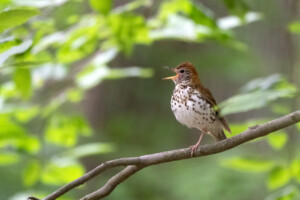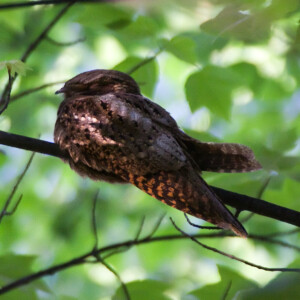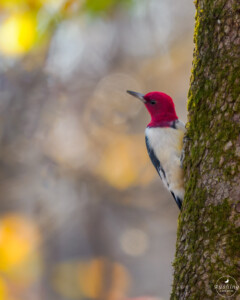By Dottie Head, Birds Georgia
January 5 is National Bird Day, a day designed to shine the spotlight on issues critical to the protection and survival of birds. Why should we care about birds? In addition to adding beauty and natural pest control in our landscapes, birds are indicator species. Bird health is intrinsically linked with our own.

A groundbreaking study published in the journal Science in 2019 revealed three billion, or one in four birds, have disappeared from our landscapes in the past 50 years, including common birds, like Barn Swallows and Wood Thrush; grassland birds, like Eastern Meadowlarks; and migratory birds, like Baltimore Orioles. Birds are declining due to a myriad of threats ranging from habitat loss and overuse of pesticides to reflective glass and predation by outdoor cats. This study should sound the alarm for all of us, as the disappearance of these birds indicates a general shift in our ecosystems’ ability to support basic birdlife.
Birds and people both need healthy habitats to thrive. By maintaining healthy forests and employing sound forest management practices that take birds into consideration, land and forest managers can play a huge role in creating and maintaining a functioning native ecosystem that benefits all organisms, including birds, wildlife, and people.
Forests Are Critical Habitat

Diverse, native forest habitats support more bird species than other habitat types. Managing forests for birds can be compatible with managing forests for other purposes, including financial gain. In general, large, unfragmented forest blocks provide better habitat, especially for breeding birds, than small forested areas. The edges created by small forest fragments allow predators and nest parasites, (like Brown-headed Cowbirds which lay their eggs in other birds’ nests) easier access to nests. Prioritizing and maintaining large blocks of forest, especially those along waterways, wetlands, and ephemeral streams, is one of the best ways to benefit birds and wildlife. That said, there is still great value in diversity of habitat across the landscape to support a wider array of species. In places where forest can not be managed as a continuous unit, grasslands, wetlands, and early successional habitat should be kept, prioritizing the support of native plant species. Understanding and supporting the habitats that were historically present allows for land management goals to more easily be met.
Native v. Non-native plants
Native plants provide wildlife with food and shelter, and plant diversity correlates strongly with bird diversity. One of the easiest ways we can help birds and other wildlife is to support native plants and add them to our landscapes when appropriate. Incorporating native plants into the landscape should start at your home as many of the non-native invasive plants across our wild spaces come from home landscaping filled with non-native, ornamental species that end up outcompeting our native flora and spilling into forest, pastures, and grasslands. Native plants are built to thrive in their environment, and these plants are important hosts for protein-rich native insects, like caterpillars, which nesting birds need to feed their growing chicks. More than 96 percent of land birds feed insects to their chicks, and native plants host many more insects than non-native plants.
Non-native plant species that have overtaken areas are termed invasive. Common examples of invasive species in Georgia include Chinese privet, Japanese honeysuckle, multiflora rose, Bradford pear, and kudzu. These species outcompete native plants and provide less nutritious food for migrating birds and other wildlife. Removing and treating invasive plant species on your land can provide great benefits for birds, particularly during the breeding season.
As a general rule, land managers should retain and preserve a diversity of native trees, especially those with large crowns, and prioritize the removal of invasive, exotic plants that destroy natural ecosystems. This can be done slowly over time by manual removal or with carefully planned and executed herbicide applications directly targeting invasive plants. It is also important to avoid broad spectrum spraying of herbicides for invasive plant removal to maintain any native plant diversity that is still present. Once non-native plants have been removed native plants may rebound on their own but in some cases native plants and seeds may need to be added.
The goal should be to create structural diversity with overstory and understory trees, as well as shrubs and groundcovers. Timing is important, too. The fruits and flowers of most native plants ripen at the same time migratory birds are passing through, providing a high-fat, nutritional food source to help birds complete their migratory journeys. In addition to providing food for pollinators and birds, habitats filled with native plants help reduce stormwater run-off and mitigate the effects of climate change. Reducing mowing and avoiding mowing in natural areas during nesting season is also important.
Where possible, dead trees (or snags) should be retained to provide food sources and nesting habitat for insect eating and cavity nesting birds. Allowing leaf litter to remain where it falls also provides habitat for insects and other invertebrates on which birds feed.
Prescribed Fire
Prescribed fire, when conducted responsibly, can be very beneficial for forests and birds. Controlled burns influence forest structure, which has indirect benefits for many bird species. In particular, prescribed fires can benefit forest understory development, create snags (standing dead trees), and generate coarse woody debris. Fire stimulates ground cover regeneration which is critical for a wide variety of beneficial insects including pollinators and lepidoptera which are an important food source for birds. Fire is critical for maintaining forest stands that can best support species such as the Chuck-Will’s-Widow, Whip-poor-will, and Red-headed Woodpecker. The benefits of fire in fire-adapted forest ecosystems are well documented, and managers should consider employing fire to create and maintain habitat types and structures.
Responsible Stewardship
Acting as good stewards of the land has positive impacts on wildlife. Use chemical fertilizers sparingly and avoid using pesticides or pesticide-coated products that eradicate food sources for birds and wildlife. This includes mosquito sprays and neonicotinoids. Encourage biological controls of mosquitoes and other insect pests with nest boxes, chimney swift towers, and bat boxes to provide homes for birds and other insectivores.
 Provide no support for feral or outdoor cats as they are not natural predators in our ecosystems. According to the American Bird Conservancy, predation by domestic cats is the number-one direct, human-caused threat to birds in the U.S and Canada. In the United States alone, outdoor cats kill approximately 2.4 billion birds every year. Although this number may seem unbelievable, it represents the combined impact of tens of millions of outdoor cats.
Provide no support for feral or outdoor cats as they are not natural predators in our ecosystems. According to the American Bird Conservancy, predation by domestic cats is the number-one direct, human-caused threat to birds in the U.S and Canada. In the United States alone, outdoor cats kill approximately 2.4 billion birds every year. Although this number may seem unbelievable, it represents the combined impact of tens of millions of outdoor cats.
Finally, minimize unnecessary outdoor lighting, and use down-shielded lamps and motion activated lighting where outdoor lighting is needed. Lighting has been shown to disorient birds, especially during migration and bring them into areas where they would be at greater risk to predation by cats and collisions with windows.
Building Places Where Birds and People Thrive
Recognizing the inherent connection between native plants and birds, Birds Georgia has been restoring bird-friendly habitat across Georgia, at places like Jekyll Island, Panola Mountain State Park, and along the Chattahoochee River to name just a few. In partnership with foresters and other conservation professionals, we’re working to improve landscapes across Georgia for the benefit of birds and people, too. The restoration team focuses largely on removing non-native and invasive plants from the landscape to better support native plants and the birds that rely on them.
Learn more about our work at https://www.birdsgeorgia.org/
About Birds Georgia: Birds Georgia is building places where birds and people thrive. We create bird-friendly communities through conservation, education, and community engagement. Founded in 1926 as the Atlanta Bird Club, the organization became a chapter of National Audubon in 1973, and continues as an independent chapter of National Audubon Society today. We look forward to celebrating the 100- year anniversary of our organization in 2026. Learn more at https://www.birdsgeorgia.org/
